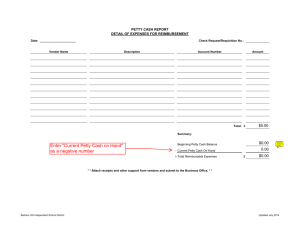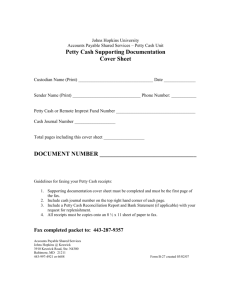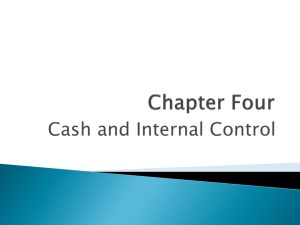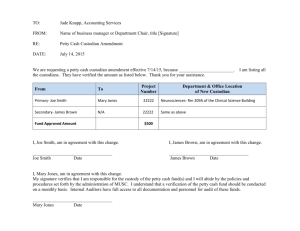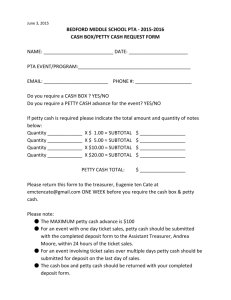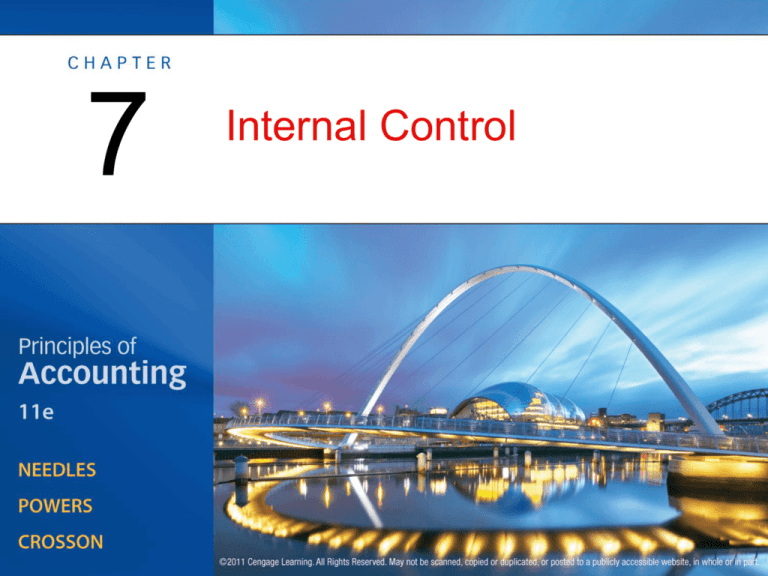
7
Internal Control
Management Issues Related to Internal
Control
OBJECTIVE 1: Identify the management
issues related to internal control.
Management Issues Related to Internal
Control
• The two objectives of a good system of
internal control are to ensure
– The reliability of accounting records and
financial statements
– That the company’s assets are protected
Management Issues Related to Internal
Control
• The need for internal controls
– Use inventory to illustrate the need for internal
controls
The Need for Internal Controls (cont.)
• Physical inventory
– A physical inventory must be taken in both the
periodic and the perpetual inventory systems.
– Inventory includes all salable goods owned by
the business, regardless of location.
– Choice of fiscal year is influenced by the need
to take a physical inventory.
– Technology has an impact on the taking of a
physical inventory.
The Need for Internal Controls (cont.)
• Inventory losses result from theft and
spoilage and are included in cost of goods
sold; these losses are easier to track under
the perpetual system than under the
periodic system.
Management Issues Related to Internal
Control
• Management’s responsibility for internal
control
– Responsibility applies to management of all
companies, large and small.
– The Sarbanes-Oxley Act of 2002 (SOX)
applies to all public companies.
– SOX requires certification of internal controls
by the CEO, CFO, and auditor.
©2011 Cengage Learning All Rights Reserved. May not be scanned, copied or duplicate, or posted to a publicly accessible website, in whole or in part.
Internal Control: Components, Activities,
and Limitations
OBJECTIVE 2: Describe the components of
internal control, control activities, and
limitations on internal control.
Internal Control: Components, Activities,
and Limitations
• Internal control has five components:
– Control environment
• The control environment reflects management’s
philosophy and operating style, the company’s
organizational structure, methods of assigning
authority and responsibility, and personnel policies
and practices.
– Risk assessment
• Risk assessment entails identifying areas in which
risk of asset loss or inaccuracy in accounting
records is especially high.
Internal Control: Components, Activities,
and Limitations
• Internal control has five components
(cont.):
– Information and communication
• Information and communication relates to the
accounting system established by management and
to the need for clear communication of each
individual’s responsibility within that system.
Internal Control: Components, Activities,
and Limitations
• Internal control has five components
(cont.):
– Control activities
• Control activities are the specific procedures and
policies established by management to ensure that
the objectives of internal control are met.
– Monitoring
• Monitoring involves management’s regular
assessment of the quality of internal control.
Internal Control: Components, Activities,
and Limitations
• Control activities include the following:
–
–
–
–
Requiring authorization for all transactions
Recording all transactions
Using well-designed documents
Implementing physical controls, as over the accounting
records
– Establishing a system of independent periodic checks
of records and assets
– Separating duties
– Using sound personnel procedures
• Bonding is a valuable control procedure.
Internal Control: Components, Activities,
and Limitations
• At least three factors can contribute to the
weakening of a system of internal control:
– Human error
– Collusion
– Changing conditions
©2011 Cengage Learning All Rights Reserved. May not be scanned, copied or duplicate, or posted to a publicly accessible website, in whole or in part.
Internal Control over Merchandising
Transactions
OBJECTIVE 3: Apply internal control
activities to common merchandising
transactions.
Figure 1: Internal Controls in a Large Company:
Separation of Duties and Documentation
Figure 2: Internal Control Plan for
Purchases and Cash Disbursements
Figure 2: Internal Control Plan for Purchases and
Cash Disbursements (cont.)
Internal Control over Merchandising
Transactions
• Internal control activities help prevent theft
and fraud and promote accuracy in cash
records.
Internal Control over Merchandising
Transactions
• Internal controls also help management by
– Keeping enough inventory on hand to sell to
customers without overstocking merchandise
– Keeping sufficient cash on hand to pay for
purchases in time to receive discounts
– Keeping credit losses as low as possible by
making credit sales only to customers who are
likely to pay on time
Internal Control over Merchandising
Transactions
• Control of cash
– Administrative controls such as a cash budget
help maintain adequate inventory and cash
levels and minimize credit losses.
Control of cash
• Generally, the following are necessary for good
control of cash:
– Separate the functions of authorization, recordkeeping,
and custodianship of cash.
– Limit the number of people who have access to cash,
and designate who those people are.
– Bond all employees who have access to cash.
– Keep the amount of cash on hand to a minimum by
using banking facilities as much as possible.
Control of cash
• Generally, the following are necessary for good
control of cash (continued):
– Physically protect cash on hand by using cash
registers, cashiers’ cages, and safes.
– Record and deposit all cash receipts promptly, and
make payments by check rather than by currency.
– Have a person who does not handle or record cash
make unannounced audits of the cash on hand.
– Have a person who does not authorize, handle, or
record cash transactions reconcile the Cash account
each month.
Internal Control over Merchandising
Transactions
• Control of cash receipts
– Two or more persons should handle cash
received by mail.
– Cash received over the counter should be
controlled with cash registers and prenumbered
sales tickets.
Internal Control over Merchandising
Transactions
• The following documents should be used when
making a purchase:
– Purchase requisition
• A purchase requisition is a formal request for a purchase that a
department submits to the company.
– Purchase order
• The department responsible for purchasing activities
completes a purchase order and sends it to the vendor.
– Invoice
• An invoice is the bill that the vendor sends to the buyer.
Internal Control over Merchandising
Transactions
• The following documents should be used
when making a purchase (continued):
– Receiving report
• A receiving report, completed by the receiving
department, contains information about the quantity
and condition of goods received.
– Check authorization
• A check authorization is a document showing that
the purchase order, invoice, and receiving report are
in agreement and that payment is therefore
approved.
Internal Control over Merchandising
Transactions
• The following documents should be used when
making a purchase (continued):
– Check
• When payment is approved, a check is issued to the vendor for
the amount of the invoice, less any appropriate discount. A
remittance advice should be attached to the check, describing
what the check is for.
– Bank statement
• When the vendor deposits the check, then the canceled check
appears on the bank statement. IF the check amount is
incorrect or has been altered, it will show up here.
©2011 Cengage Learning All Rights Reserved. May not be scanned, copied or duplicate, or posted to a publicly accessible website, in whole or in part.
Petty Cash Funds
SUPPLEMENTAL OBJECTIVE 4: Demonstrate
the use of a simple imprest (petty cash)
system.
Figure 3: Petty Cash Voucher
Petty Cash Funds
• Petty cash fund
– Purchase of items of small value
– Petty cash fund controlled through an imprest
system.
Petty Cash Funds
• Establishment of a petty cash fund.
– A petty cash fund is established for a fixed
amount.
– When payment is made from the fund, the
fund’s custodian prepares a petty cash voucher
showing the date, amount, and purpose of the
expenditure.
– The person who receives payment signs the
voucher.
Petty Cash Funds
Petty Cash Funds
• Petty cash fund replenished using Cash
Short or Over if necessary.
– The petty cash fund is replenished periodically
and at the end of an accounting period.
– All the expenses since the last replenishment
are debited and Cash is credited.
– Discrepancies are recorded as Cash Short or
Over.
Petty Cash Funds
©2011 Cengage Learning All Rights Reserved. May not be scanned, copied or duplicate, or posted to a publicly accessible website, in whole or in part.

